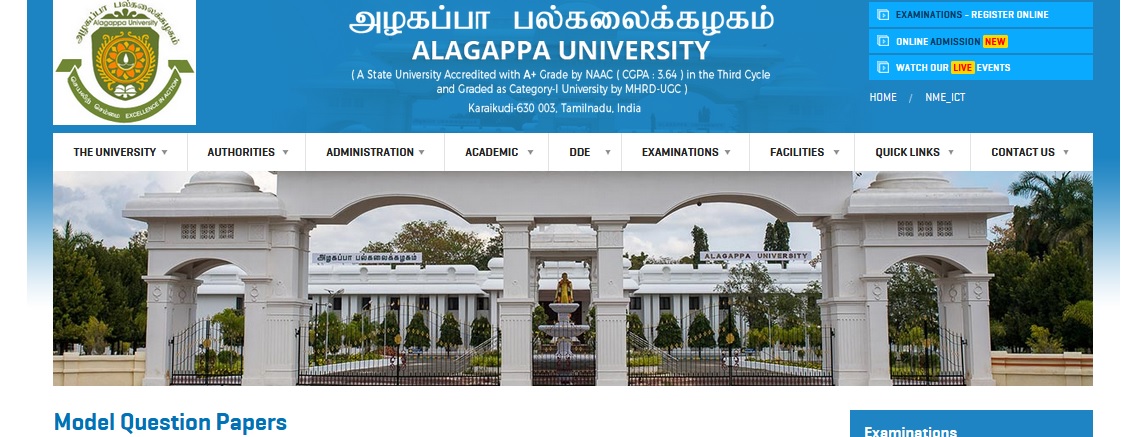Human Physiology B.Sc Model Question Papers : alagappauniversity.ac.in
Name of the University : Alagappa University
Degree : B.Sc
Department : Home Science
Subject Code/Name : Human Physiology
Semester : I
Document Type : Model Question Papers
Website : alagappauniversity.ac.in
Download Model/Sample Question Paper :
Nov 2010 : https://www.pdfquestion.in/uploads/alagappauniversity.ac.in/4010.-B.Sc.%20Home%20Science%20%5BNon-CBCS%5D.pdf
Alagappa University Human Physiology Question Paper
Time : 3 Hours
Maximum : 100 Marks
Part – A :
1. Homeostasis.
2. Tachycardia.
3. Diarrhoea.
4. Antibodies.
5. Vasodilator.
6. Erythrocytes.
7. Clot.
8. Hypertension.
9. Anaemia.
10. Sneeze reflex.
11. Explain myocardial infarction.
12. Mention the types of special senses.
13. Write notes on types of leukocytes.
14. Explain ‘Inflammation’
15. What is meant by ‘Blood Typing’ –

16. Expand ECG. How is it done –
17. Illustrate the structure of the lung and label its parts.
18. What is asthma – How is it caused –
19. How is pneumonia caused – Explain the abnormalities caused by pneumonia.
20. What do you mean by ‘Cataract’ – How does it occur –
21. Explain the process of the ‘Menstrual cycle’.
22. Describe in detail the digestive mechanism of Carbohydrates.
23. Briefly explain Diabetes Mellitus.
Nutritional Biochemistry
1. Give any two scopes of studying Biochemistry.
2. What is meant by passive diffusion –
3. Write the structure of starch.
4. Briefly explain Phospholipids.
5. What is enzyme inhibition –
6. Write short notes on Ketone bodies.
7. What is meant by high energy PO4 bond –
8. List the types of lipo-protein.
9. Mention the composition of nucleic acid.
10. Explain the structure of amino acids.
11. Explain the molecular transport of nutrients.
12. Discuss the structure and properties of disaccharides.
13. List the significance of iodine value and saponification value.
14. Write short notes on EAA and NEAAs.
15. List the factors affecting velocity of enzyme.
16. Explain- – oxidation of fatty acids.
17. Briefly outline fatty liver.
18. What is oxidative phosphorylation –
19. Mention the biosynthesis of fatty acids.
20. Write short notes on electrolyte balance.
21. Discuss essential fatty acids, in detail.
22. Explain ‘Biological oxidation with reference to (i) Citric acid cycle and
23. Discuss vitamin ‘C’ in human nutrition.
Human Nutrition
1. What is direct calorimetry method of measuring energy –
2. Mention the foods which provide Carbohydrates.
3. Mention any four methods of preventing PEM.
4. What is Kwashiorkor –
5. What is Anaemia –
6. Enlist the complications in Pregnancy.
7. Give the biological role of macro minerals.
8. What is energy balance –
9. What are the physiological changes in old age –
10. What do you understand by the termweaning food –
11. How will you measure energy through direct calorimetry method –
12. What are the various causes and symptoms of PEM –
13. Define Fiber. Classify fiber and explain its nutritional role.
14. What are Vitamins – Classify Vitamins.
15. Explain the functions of micro and macro minerals.
16. Bring out the importance of Anthropometry.
17. Define Malnutrition. What are the causes and symptoms of malnutrition –
18. Plan a menu for preschool and school going children.
19. What are the general problems of old age –
20. What are supplementary foods –
Part – C : (2 × 20 = 40)
Answer any two questions out of three questions.
21. Explain the following terms :
(a) Food Fads, Anorexia nervosa.
(b) Basal metabolism.
(c) Meal planning.
(d) Nutrition.
22. What are the various causes, symptoms and prevention of carbohydrate deficiency ?
23. What are the various functions of minerals ? Explain the causes, symptoms and prevention of mineral deficiency.
B.Sc. Degree Examination, November 2010 :
Diet Therapy—I :
(Non-CBCS—2004 onwards)
Duration : 3 Hours
Maximum : 100 Marks
Part – A (10 × 2 = 20)
Answer all questions.
1. Define Therapeutic diet.
2. Name the members of a health team.
3. Give an example for clear fluid diet and full fluid diet.
4. How do you assess obesity ?
5. List the different types of fevers.
6. Write the food which must be avoided during steatorrhoea.
7. What is short bowel syndrome ?
8. Define mal-absorption syndrome.
9. Write the consequences of sickle cell anemia.
10. Classify Pancreatitis.
Part – B : (8 × 5 = 40)
Answer eight out of ten.
11. Justify the need a team approach in health care.
12. Write the factors influence the formulation of therapeutic diet.
13. Give a brief account on intravenous feeding.
14. What is low residue and high residue diet ?
15. Describe the feeding methods for a patient who underwent a surgery.
16. Write notes on diet for a peptic ulcer patient.
17. Briefly explain constipation.
18. Mention the diet therapy for acquired disaccharide intolerance.
19. Write notes on anemia of nutritional origin.
20. Give the treatment for cholecystitis and gall stones.